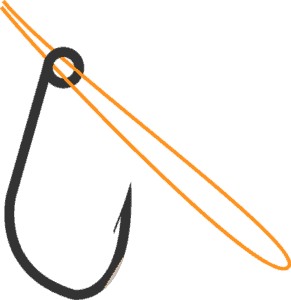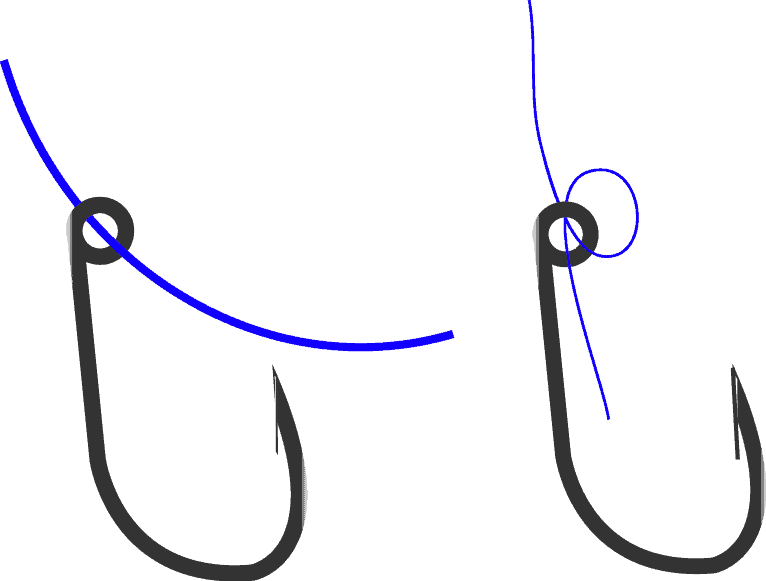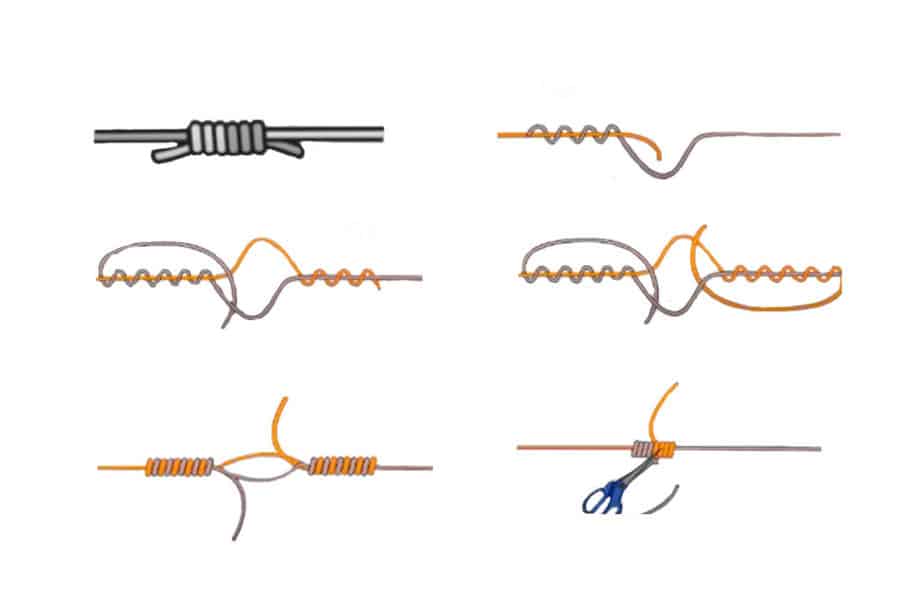If you plan to start fishing, you should at least know how to tie a fisherman’s knot. Tying a knot is not hard, but that does not mean anyone can tie a perfect knot. You will need to practice, even if it’s for a few hours, to tie a knot that will not let your fish escape.
Today, I will cover more about fishing knots and teach you how to tie some of the most common fishing knots. But before I get to that, I think it is important to help you choose the right fishing line for the job.
Selecting the Right Fishing Line
The quality of a fishing line plays a vital role in the strength and functionality of a knot. There are various types of fishing lines, but you will use almost all types of fishing lines at some point. That said, here is what you need to know about the available fishing lines.
Monofilament
Monofilament fishing lines are among the most common fishing lines. They are usually recommended for top fishing since they come with great buoyancy. Monofilament lines are also recommended for anglers who often go out fishing. This is because the monofilament line can easily straighten out again if you store it for a long time without using it.
Monofilament lines are usually cheap, but they don’t last as long as their alternatives. The lines weaken with the absorption of water, and friction affects them a lot. It is advisable to replace a monofilament line regularly.
Braided Fishing Line
Braided lines have been in the market for a long time. The lines come with high knot strength and do not stretch, making them perfect for some situations. The fishing line is particularly popular for deep fishing since it has a larger diameter than its alternatives, plus it provides better resistance to abrasion.
Braided lines are excellent for casting, even over longer distances. The lines are usually best for high-quality fishing reels and rods. With a good rod and reel, a braided fishing line will last for years.
Fluorocarbon Fishing Line
Fluorocarbon lines are becoming quite popular, and it is for good reasons. These lines are usually heavy, and they are almost invisible in the water, meaning even cautious fish like trout cannot notice them. The lines dive faster in the water, and they are excellent for deep fishing.
Fluorocarbon lines also don’t suck up water. Finally, these lines resist deterioration from acid, gasoline, and sunlight.
However, you should always be attentive to the balance of the tackle while using a fluorocarbon line. This means if you use a heavier line, you need to use heavier lures, rods, and reels. Similarly, use a lighter fluorocarbon line if you use a lighter lure, reel, and rod.
The above three are the most common types of fishing lines, but there others, which include:
- A Trolling line: A fishing line that comes with artificial or natural baited hooks.
- Fly line, which is mostly used for fly fishing.
Factors to Consider While Purchasing a Fishing Line
Now that you know the five major types of fishing lines, it’s time to learn about what you should consider while choosing the one that meets your needs. Here are the factors you should consider:
Diameter
A fishing line’s diameter affects its stretch, castability, visibility, and how deep it can run. Typically, the less the diameter, the less the visibility of the line in the water. However, a too-thin line may not be strong enough to land some larger fish.
Color
The color of a fishing line also affects its visibility, and it is wise to choose a line that is as less visible as possible in most situations. A visible fishing line may scare the fish away, which is not ideal. However, a highly visible line may be handy in low-light conditions, for example, at dawn or night. During such times, you will need a visible line so you can notice the line’s movement once the fish takes the bait.
Stiffness
Typically, a line will be stiffer if it has a larger diameter. In most cases, stiffer lines are usually harder to cast. On the other hand, stiffer lines are stronger.
Abrasion Resistance
Fishing lines are usually subjected to unsuitable conditions such as rocks and trees while fishing. Considering that, most lines are designed to be abrasion-resistant. Typically, the thicker the line, the more abrasion-resistant the line is.
Line Strength
The strength of a fishing line is measured in pounds and indicated on the fishing line package. For the best fishing experience, buy a fishing line that roughly matches the weight of the fish you plan to catch. For example, use a 30-pound line test if you plan to catch tunas weighing up to 30 pounds.
Line Memory
A fishing line memory is not the same as a human or a computer. In fact, you should always consider buying a fishing line with less memory. That’s because memory means the ability of the line to retain shape after deformation. Lines with zero memory stay straight, which is perfect for a fishing line. A fishing line with zero memory comes off the spool easily, allowing smoother casts.
As you choose a fishing line, it is essential to note that there is no fishing line perfect for all fishing conditions. You must consider your fishing conditions and the size of the fish you want to catch while selecting a fishing line.
6 Fishing Knots Every Angler Should Know
The Fisherman’s knot, also known as the Improved Clinch Knot, is the most common one, especially among beginners. It is easy to tie, and the instructions are pretty straightforward. The knot is also strong enough, and you can use it for all fish. To make your understanding easier, I will first explain the terms commonly used while tying knots.
- Standing line: The longer line running towards the reel
- Tag end: It’s the end of the fishing line where one ties the knot.
- Turn: Also called the wrap, it occurs when you pass the tag end around the standing line.
How to Tie a Fisherman’s Knot
Now that you understand the terms used, follow these steps to tie a fisherman’s knot easily:
- Run around 8-10 inches of line through the hook’s eye.
- Turn the tag end around the standing line for five turns.
- Form another loop by passing the tag end through the one next to the hook eye. The formed loop will include the wraps (the five turns you made).
- Now pass the tag end through the “new” loop.
- Moisten the loop with some saliva to help lubricate the knot you will form.
- Hold the standing line, and the tag end in one hand and the hook’s bend on the other hand.
- Pull steadily. Please be careful while holding the hook since it is usually very sharp and can lead to an accident.
- Tighten the knot slowly without applying too much pressure.
- Use your scissors or clippers to cut the tag end such that only a 1/8-inch of it is left.
Tips: A fingernail clipper is a fantastic tool for clipping the tag end and makes a clean cut. Also, instead of leaving the tag end at 1/8, you can make it ¼ inch long and touch the end with a hot surface like a blown-out match to create a ball end. A ball end prevents the tag end from pulling out if under stress while fishing.
The Fisherman’s knot is the most basic fishing knot, but it does not mean it’s the only knot you can use. There are other knots you can try if you don’t feel comfortable with the improved clinch knot. These knots include:
Palomar Knot

Palomar knot is considered as one of the strongest knots. You can use this knot to secure a swivel or hook to the end of the line, and it does a pretty good job. Additionally, you can use the knot to fasten a fly to the leader line if you use flies while fishing. Here’s how to go about it:
- Double six inches of the fishing line and pass it through the hooks eye.
- Tie a simple overhand knot on the line (doubled line) and allow the hook to hang loose. Please make sure not to twist the line while at it.
- Pull the loop down and pass it over the hook.
- Moisten the ends of the lines with saliva and pull them against each other to create a knot.
- Clip the excess line to live about 1/8 inch of the tag end.
Trilene Knot

The Trilene fishing knot is usually used with monofilament lines as it is designed by Berkley for that purpose. The knot is great for joining lures, leaders, and swivels to mono fluorocarbon fishing lines. The knot easy to tie, and if you plan to use a monofilament line, you should learn how to tie it.
- Form a small loop by running the tag end through the eye of the hook.
- Pinch the formed loop between your forefinger and thumb and wrap the tag end around the standing line for about five times.
- Pass the line’s end through the loops formed after wrapping the tag end around the standing line.
- Moisten the line before drawing the line tightly to form a strong knot.
Surgeon’s Knot
This knot is particularly important when you want to tie two pieces of a fishing line together. You can also use it when using a fishing line that has different diameters. The knot is easy to tie, and even a beginner can master it within a short time.

- Bring the leader line and main line close to each other.
- Pass the long end of the leader line and the tag end of the fishing line through the loop to form an overhand knot.
- Pass the tag end and long end of the leader line through the loop once more to form another overhand loop.
- Moisten the four ends and pull them slowly until the knot is tight enough.
Blood Knot

This is another knot you should learn if you plan to connect two pieces of a fishing line together. The knot is also exceptional for fly fishing. Please note that the two fishing lines you want to bring together should be of the same diameter. If not, they should be at least almost the same size. Here is how to tie the blood knot:
- Overlap the two fishing lines you want to join. Now, twist one of them around the other and make five turns before bringing the tag back between them (the fishing lines).
- Repeat the above step; only this time, do the opposite. Twist the other line around and make five wraps.
- Now, pull the lines in the opposite direction.
- Cut the tags, and you are good to go.
Tucked Sheet Bend
If you want to attach a fishing line to a leader loop, you should learn how to tie this knot. You can also use the line to attach a snelled hook to the fishing line. The knot is easy to tie, and even a beginner can tie it with a few hours of practice.
- Pass the line’s end through the loop and make a simple sheet bend knot.
- Now pass the end of the main line back through the simple sheet bend’s loop.
- Tighten it until it snugs, and that’s it.
I know learning how to tie a knot with braided fishing line or any other type of line is easier said than done, but with a few hours of practice, you will be at least be good at tying one or two knots. Learn how to learn the easiest knots as you graduate to more complex knots.
Basic Fishing Knot Tips Every Angler Should Know
A fishing knot is usually the weakest link between you and the fish you plan to catch. Suppose the knot is not well-tied, the chances of losing the fish increase drastically. This can be frustrating and can make your fishing experience not as fun as it should be.
That said, it is essential to know these fishing knots tips to ensure you don’t make any mistakes while fishing. But before I discuss the tips, I want to mention several things that matter a lot while tying fishing knots.
One thing that matters a lot is the type of fishing line you are using. A knot can never be better than the fishing line you are using. That’s why it is crucial to use fishing lines of the highest quality from trusted brands.
Secondly, store spare spools of line in a dry container, and place them in a dark and cool place. Doing so plays a significant role in preventing deterioration.
Finally, always inspect your fishing line and replace it whenever necessary, for example, when the line shows signs of wear, abrasion, or damage.
Pro Tip: Always cut off monofilament (nylon) leader lines after they have spent an extended amount of time in the water. Generally, monofilament lines usually weaken with water absorption, unlike fluorocarbon or braided lines.
A monofilament line typically loses up to 15 percent of its strength if it stays in the water for about 60 minutes. That means a knot with 90% of its strength tied to a 10-pound test line will start with nine pounds of strength, and by the time you’ve fished for about one hour, the line’s strength will be about seven pounds.
Replacing a monofilament line that has been in the water adds strength to it, and that’s not all. A new line also has more buoyancy compared toa waterlogged one. Since monofilament lines are mostly used for top-water presentations, more buoyancy is a great advantage.
Knot Essential Tips
Generally, a knot can fail because of two reasons:
- Slippage
- Breakage
Slippage can occur either because of tying the wrong fishing knot for the line you are using or tying the right knot wrongly. On the other hand, breakage can result from a strain that exceeds the knot’s strength or tying a knot improperly. You can avoid breakages and slippages by following these basic fishing knot tips.
- Use the right knot for the fishing line you plan to use. Some knots are better with monofilament lines, while others are good for braided lines. To know the right knot for your fishing line, check the line’s manufacturer website. In most cases, they recommend the right knot for their line.
- Don’t just select a knot just because it is popular or familiar. You must keep your purpose in mind while choosing the knot. Some knots are excellent for line to line while others are great for a line to lure, etc. I’ve mentioned the best times to use the different knots above. Make sure to use each knot for its purpose.
- Use the knot that is easier to master. While some knots are stronger than most, they are too complex to tie, and if you tie one incorrectly, you increase the risk of slippage and breakage. Choose a knot you can tie even under strenuous circumstances such as when it’s raining or pressured to tie a knot fast.
- Choose a versatile knot. For example, choose a knot that you can use for attaching a line to hook, swivel, and lure. If you use such a knot, you don’t need to master several knots for each purpose, hence making your work easier. However, it is still important to learn several other knots for other purposes.
- Before tying a fishing knot for water use, first practice at home with shoelaces, for example, until you perfect. After getting better with a shoelace, you can use the fishing line you plan to use and practice how to tie until you become fast and accurate at it. Practice until you don’t need to think about the steps while tying the knot.
- Always lubricate the knot before tightening. By doing so, you reduce friction and hence the chances of breakage. Friction causes heat on the knot, weakening the fishing line, which increases the chances of breakage. Most people use saliva as a lubricant, but you can also use water.
- After tightening the knot, apply gradual pressure on the main line by pulling it to ensure the knot is tied appropriately. If it is not, it will slip apart in your hands. I think it is better it slips on your hands than when you are about to land a fish.
- Be very careful while cutting the tag ends not to clip the knot. Ensure not to trim too close to the knot. Also, ensure to use clippers or scissors made for the specific line to avoid placing unnecessary strain on the knot. Please don’t use your teeth to cut the excess line as it can even lead to a tooth’s chipping.
- Inspect all the knots you’ve made and ensure all the turns are correctly laid out. Overlapping turns (wraps) can add unnecessary pressure on the underlying turn, leading to breakage. If a knot looks different from the others (odd), there is a high chance you didn’t tie it appropriately. Cut it and retie it appropriately.
- Whenever possible, tie the fishing knots before going out fishing. That way, you will avoid possible location difficulties such as rain and other field conditions.
- If your rod tip guide uses a metal like chromium, consider replacing it with a guide that uses insert material such as Alconite® to protect the line from more friction.
- Inspect your knots after each catch. If you notice a knot that has shifted on the eye of the hook, or anything else uncommon, readjust it. If the knot looks odd, retie it to decrease the chances of losing a fighting fish.
- Normalize retying your fishing knots even when they look just fine. This is because the knots may be looking fine, but strains have weakened them during fishing. Retie more often if you regularly land larger fish.
If you put the above tips into practice, the likelihood of your fishing knot failing will be very low. The good thing is the tips are easy to master; you just need to follow them at all times. In fact, you should consider these tips the rules for tying fishing knots.
Frequently Asked Questions about Fishing Knots
If you still have some questions about fishing knots, this is where you find the answers. Here are the answers to FAQs about fishing knots:
What is the Strongest Fishing Knot?
As I’ve discussed above, there are various fishing knots, but they all come with different strengths. Among all, the Palomar fishing knot is considered the strongest. The knot is not that hard to tie, and it won’t take you a lot of time.
One major advantage of the Palomar knot is you can use it for both monofilament and braided lines. Therefore, if you want to know how to tie the strongest fishing knot, you should practice how to tie a Palomar knot.
Is a Palomar Knot Good for Monofilament Line?
Yes, you can use the monofilament line for monofilament to create a strong knot. It is as good with monofilament as it is with a braided line.
What is the Most Complex Knot?
There are many fishing knots, and what can be hard for me may be easy for you. Some people believe that the Fisherman’s knot is the easiest knot to tie, but some people find it quite challenging and prefer a Palomar knot.
That said, one of the knots considered complex by most people is the PR Bobbin Knot. The knot is expected to hold still 100% of the time, and it is one of the strongest knots. It will most probably take you some time to master, but it is always worth the time.
What are the Best Knots for Monofilament Line?
At some point, you have to use a monofilament line during your fishing. There are several knots you can use for the monofilament line, and the following are the ones I recommend:
- Surgeon’s knot: It is easy to tie and strong enough.
- Fisherman’s knot: Considered the easiest knot to tie, and it gets the job done
- Palomar knot: Considered the strongest fishing knot and it is good for both monofilament and braided lines
Tips for Catching More Fish
Now that you have the right fishing line and you know how to tie a knot in fishing line for crafts, what remains is going out and catching some fish. Catching fish should not be hard when you have the right gear, but you can increase your chances of landing more fish by following the following tips.
- Always go out fishing after you’ve ensured that you have carried everything.
- Pick the right bait for the clarity of the water.
- Don’t fish only in one area.
- Consider the season while going out fishing because different seasons require different approaches.
- Pay attention to the surrounding when casting. Some indications like lily pad fields or cicadas singing, may indicate a great site to cast.
Wrapping up
Thank you for going through this guide about how to knot a fishing line. By now, you can at least tie some of the basic fishing knots. In summary, here are the things contained in this guide:
- How to tie basic fishing knots, including Fisherman’s knot, Palomar knot, Surgeon knot, and more.
- Tips/rules for tying fishing knots
- What to consider while buying a fishing line
- Tips to land more fish.
Hopefully, that information will provide you with everything you need to know about fishing knots. Stay tuned for more informative articles.
